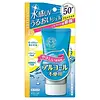What's inside
What's inside
 Key Ingredients
Key Ingredients

 Benefits
Benefits

 Concerns
Concerns

 Ingredients Side-by-side
Ingredients Side-by-side

Water
Skin ConditioningEthylhexyl Methoxycinnamate
UV AbsorberAlcohol Denat.
AntimicrobialButylene Glycol
HumectantIsononyl Isononanoate
EmollientMethylene Bis-Benzotriazolyl Tetramethylbutylphenol
UV FilterSodium Hyaluronate
HumectantHydrolyzed Collagen
EmollientArginine
MaskingLeather Coral Extract
Skin ConditioningVaccinium Myrtillus Fruit Extract
Skin ConditioningDiethylamino Hydroxybenzoyl Hexyl Benzoate
UV FilterGlycol Dimethacrylate Crosspolymer
Bis-Ethylhexyloxyphenol Methoxyphenyl Triazine
Skin ConditioningPolysilicone-13
PEG-40 Stearate
EmulsifyingBis-PEG-18 Methyl Ether Dimethyl Silane
EmollientAcrylates/C10-30 Alkyl Acrylate Crosspolymer
Emulsion StabilisingMelaleuca Alternifolia Leaf Oil
AntioxidantDecyl Glucoside
CleansingPolystyrene
Polyvinyl Alcohol
Xanthan Gum
EmulsifyingDisodium EDTA
Propylene Glycol
HumectantPhenoxyethanol
PreservativeWater, Ethylhexyl Methoxycinnamate, Alcohol Denat., Butylene Glycol, Isononyl Isononanoate, Methylene Bis-Benzotriazolyl Tetramethylbutylphenol, Sodium Hyaluronate, Hydrolyzed Collagen, Arginine, Leather Coral Extract, Vaccinium Myrtillus Fruit Extract, Diethylamino Hydroxybenzoyl Hexyl Benzoate, Glycol Dimethacrylate Crosspolymer, Bis-Ethylhexyloxyphenol Methoxyphenyl Triazine, Polysilicone-13, PEG-40 Stearate, Bis-PEG-18 Methyl Ether Dimethyl Silane, Acrylates/C10-30 Alkyl Acrylate Crosspolymer, Melaleuca Alternifolia Leaf Oil, Decyl Glucoside, Polystyrene, Polyvinyl Alcohol, Xanthan Gum, Disodium EDTA, Propylene Glycol, Phenoxyethanol
Water
Skin ConditioningMethoxycinnamic Acid
StabilisingDiethylamino Hydroxybenzoyl Hexyl Benzoate
UV FilterPentylene Glycol
Skin ConditioningSodium Acetylated Hyaluronate
HumectantSodium Hyaluronate
HumectantHydrolyzed Hyaluronic Acid
HumectantAorta Extract
Skin ConditioningAloe Barbadensis Leaf Extract
EmollientRoyal Jelly Extract
Skin ConditioningIsononyl Isononanoate
EmollientBis-Ethylhexyloxyphenol Methoxyphenyl Triazine
Skin ConditioningAcrylamide/Sodium Acryloyldimethyltaurate/Acrylic Acid Copolymer
Titanium Dioxide
Cosmetic ColorantIsohexadecane
EmollientSuccinic Acid
BufferingButylene Glycol
HumectantEthylhexylglycerin
Skin ConditioningPolysorbate 80
EmulsifyingLysine Lauroyl Glutamate
CleansingAluminum Hydroxide
EmollientStearic Acid
CleansingXanthan Gum
EmulsifyingSorbitan Oleate
EmulsifyingPhenoxyethanol
PreservativeParfum
MaskingAmmonium Acryloyldimethyltaurate/Vp Copolymer
BHT
AntioxidantT-Butyl Alcohol
PerfumingWater, Methoxycinnamic Acid, Diethylamino Hydroxybenzoyl Hexyl Benzoate, Pentylene Glycol, Sodium Acetylated Hyaluronate, Sodium Hyaluronate, Hydrolyzed Hyaluronic Acid, Aorta Extract, Aloe Barbadensis Leaf Extract, Royal Jelly Extract, Isononyl Isononanoate, Bis-Ethylhexyloxyphenol Methoxyphenyl Triazine, Acrylamide/Sodium Acryloyldimethyltaurate/Acrylic Acid Copolymer, Titanium Dioxide, Isohexadecane, Succinic Acid, Butylene Glycol, Ethylhexylglycerin, Polysorbate 80, Lysine Lauroyl Glutamate, Aluminum Hydroxide, Stearic Acid, Xanthan Gum, Sorbitan Oleate, Phenoxyethanol, Parfum, Ammonium Acryloyldimethyltaurate/Vp Copolymer, BHT, T-Butyl Alcohol
 Reviews
Reviews

Ingredients Explained
These ingredients are found in both products.
Ingredients higher up in an ingredient list are typically present in a larger amount.
You might know this ingredient as Tinosorb S or Bemotrizinol. It is a UV filter that covers both UVA and UVB rays.
This ingredient has two peak UV absorption peaks ( 310 and 340 nm) and is able to absorb both UV-A and UV-B rays. This ingredient works by preventing UV rays from reaching and damaging your skin.
On top of that - it is highly photostable and helps prevent the photodegration of other sunscreen ingredients such as avobenzone.
Tinosorb S is allowed in the EU, Australia, and Asia. It is close to being approved by the FDA and we'll hopefully get this ingredient in the U.S. by late 2025.
Fun fact: Tinosorb S is the most effective UV absorber at maximum concentration (measured by SPF) permitted in the EU.
This ingredient is oil-soluble, so your oil-cleansers will take this right off at night.
Learn more about Bis-Ethylhexyloxyphenol Methoxyphenyl TriazineButylene Glycol (or BG) is used within cosmetic products for a few different reasons:
Overall, Butylene Glycol is a safe and well-rounded ingredient that works well with other ingredients.
Though this ingredient works well with most skin types, some people with sensitive skin may experience a reaction such as allergic rashes, closed comedones, or itchiness.
Learn more about Butylene GlycolDiethylamino Hydroxybenzoyl Hexyl Benzoate (DHHB) is a chemical UV-A absorber. It is formulated for high UVA protection (320-400 nm).
DHHB is well-liked for:
DHHB has been approved by the EU, Japan, Taiwan, and South America for use up to 10%. Unfortunately, it has not been approved for use in the US or Canada due to slow regulatory processes.
This ingredient is soluble in oils, fats, and lipids.
Learn more about Diethylamino Hydroxybenzoyl Hexyl BenzoateIsononyl Isononanoate is a synthetic skin-conditioner and texture enhancer. It is created from nonanoic acid, a fatty acid found in cocoa and lavender oil.
As an emollient, Isononyl Isononanoate helps keep your skin soft and smooth. This is because emollients create a barrier on the skin to trap moisture in.
Isononyl Isononanoate helps give products a velvet feel and improves spreadability.
Learn more about Isononyl IsononanoatePhenoxyethanol is a preservative that has germicide, antimicrobial, and aromatic properties. Studies show that phenoxyethanol can prevent microbial growth. By itself, it has a scent that is similar to that of a rose.
It's often used in formulations along with Caprylyl Glycol to preserve the shelf life of products.
Sodium Hyaluronate is hyaluronic acid's salt form. It is commonly derived from the sodium salt of hyaluronic acid.
Like hyaluronic acid, it is great at holding water and acts as a humectant. This makes it a great skin hydrating ingredient.
Sodium Hyaluronate is naturally occurring in our bodies and is mostly found in eye fluid and joints.
These are some other common types of Hyaluronic Acid:
Learn more about Sodium HyaluronateWater. It's the most common cosmetic ingredient of all. You'll usually see it at the top of ingredient lists, meaning that it makes up the largest part of the product.
So why is it so popular? Water most often acts as a solvent - this means that it helps dissolve other ingredients into the formulation.
You'll also recognize water as that liquid we all need to stay alive. If you see this, drink a glass of water. Stay hydrated!
Learn more about WaterXanthan gum is used as a stabilizer and thickener within cosmetic products. It helps give products a sticky, thick feeling - preventing them from being too runny.
On the technical side of things, xanthan gum is a polysaccharide - a combination consisting of multiple sugar molecules bonded together.
Xanthan gum is a pretty common and great ingredient. It is a natural, non-toxic, non-irritating ingredient that is also commonly used in food products.
Learn more about Xanthan Gum